A Real-Time Method to Estimate the Operational Condition of Distribution Transformers
Abstract
1. Introduction
2. Materials
3. Automatic Diagnostic Method
3.1. Initialization Phase
3.1.1. Standardization
3.1.2. Dimensionality Reduction
3.1.3. Model Initialization
3.2. Modeling Phase
3.2.1. Standardization
3.2.2. Dimensionality Reduction
3.2.3. Learning Process
3.3. Operating Condition Assessment
3.3.1. Health Index
3.3.2. Operation Map
| Operation Categories | Operation Map Restrictions | |
|---|---|---|
| Appropriate | 0.92 ≤≤ 1.05 and | ≤ 1.0 |
| Precarious | (0.87 ≤< 0.92) or (1.05 <≤ 1.06) or | 1.0 <≤ 1.2 |
| Critical | (< 0.87 or > 1.06) or | I > 1.2 |
4. Results and Discussion
4.1. Initialization
4.2. Modeling
4.3. Operation Map
4.4. Health Index
4.5. General Considerations about the Case Study
5. Conclusions
Author Contributions
Funding
Data Availability Statement
Conflicts of Interest
Appendix A
Appendix B
Appendix C
References
- Simoes, M.G.; Roche, R.; Kyriakides, E.; Suryanarayanan, S.; Blunier, B.; McBee, K.D.; Nguyen, P.H.; Ribeiro, P.F.; Miraoui, A. A Comparison of Smart Grid Technologies and Progresses in Europe and the U.S. IEEE Trans. Ind. Appl. 2012, 48, 1154–1162. [Google Scholar] [CrossRef]
- Dufour, C.; Bélanger, J. On the Use of Real-Time Simulation Technology in Smart Grid Research and Development. IEEE Trans. Ind. Appl. 2014, 50, 3963–3970. [Google Scholar] [CrossRef]
- Al Mhdawi, A.K.; Al-Raweshidy, H.S. A Smart Optimization of Fault Diagnosis in Electrical Grid Using Distributed Software-Defined IoT System. IEEE Syst. J. 2020, 14, 2780–2790. [Google Scholar] [CrossRef]
- Zhan, W.; Goulart, A.E.; Falahi, M.; Rondla, P. Development of a Low-Cost Self-Diagnostic Module for Oil-Immerse Forced-Air Cooling Transformers. IEEE Trans. Power Deliv. 2015, 30, 129–137. [Google Scholar] [CrossRef]
- Arritt, R.F.; Dugan, R.C. Distribution System Analysis and the Future Smart Grid. IEEE Trans. Ind. Appl. 2011, 47, 2343–2350. [Google Scholar] [CrossRef]
- Srivastava, I.; Bhat, S.; Vardhan, B.V.S.; Bokde, N.D. Fault Detection, Isolation and Service Restoration in Modern Power Distribution Systems: A Review. Energies 2022, 15, 7264. [Google Scholar] [CrossRef]
- Swain, A.; Abdellatif, E.; Mousa, A.; Pong, P.W.T. Sensor Technologies for Transmission and Distribution Systems: A Review of the Latest Developments. Energies 2022, 15, 7339. [Google Scholar] [CrossRef]
- Yang, W.; Chang, H.; Goudarzi, A.; Ghayoor, F.; Waseem, M.; Fahad, S.; Traore, I. A Survey on IoT-Enabled Smart Grids: Emerging, Applications, Challenges, and Outlook. Energies 2022, 15, 6984. [Google Scholar] [CrossRef]
- Jin, T.; Mechehoul, M. Minimize Production Loss in Device Testing via Condition-Based Equipment Maintenance. IEEE Trans. Autom. Sci. Eng. 2010, 7, 958–963. [Google Scholar] [CrossRef]
- Mariprasath, T.; Kirubakaran, V. A Real Time Study on Condition Monitoring of Distribution Transformer Using Thermal Imager. Infrared Phys. Technol. 2018, 90, 78–86. [Google Scholar] [CrossRef]
- Jardine, A.K.S.; Lin, D.; Banjevic, D. A Review on Machinery Diagnostics and Prognostics Implementing Condition-Based Maintenance. Mech. Syst. Signal. Process 2006, 20, 1483–1510. [Google Scholar] [CrossRef]
- Jaiswal, G.C.; Ballal, M.S.; Venikar, P.A.; Tutakne, D.R.; Suryawanshi, H.M. Genetic Algorithm–Based Health Index Determination of Distribution Transformer. Int. Trans. Electr. Energy Syst. 2018, 28, e2529. [Google Scholar] [CrossRef]
- Ochella, S.; Shafiee, M.; Dinmohammadi, F. Artificial Intelligence in Prognostics and Health Management of Engineering Systems. Eng. Appl. Artif. Intell. 2022, 108, 104552. [Google Scholar] [CrossRef]
- Rediansyah, D.; Prasojo, R.A.; Suwarno; Abu-Siada, A. Artificial Intelligence-Based Power Transformer Health Index for Handling Data Uncertainty. IEEE Access 2021, 9, 150637–150648. [Google Scholar] [CrossRef]
- Jiang, J.; Chen, R.; Chen, M.; Wang, W.; Zhang, C. Dynamic Fault Prediction of Power Transformers Based on Hidden Markov Model of Dissolved Gases Analysis. IEEE Trans. Power Deliv. 2019, 34, 1393–1400. [Google Scholar] [CrossRef]
- Chanane, A.; Houassine, H.; Bouchhida, O. Enhanced Modelling of the Transformer Winding High Frequency Parameters Identification from Measured Frequency Response Analysis. IET Gener. Transm. Distrib. 2019, 13, 1339–1345. [Google Scholar] [CrossRef]
- Abu-Siada, A.; Radwan, I.; Abdou, A.F. 3D Approach for Fault Identification within Power Transformers Using Frequency Response Analysis. IET Sci. Meas. Technol. 2019, 13, 903–911. [Google Scholar] [CrossRef]
- Miyazaki, S.; Tahir, M.; Tenbohlen, S. Detection and Quantitative Diagnosis of Axial Displacement of Transformer Winding by Frequency Response Analysis. IET Gener. Transm. Distrib. 2019, 13, 3493–3500. [Google Scholar] [CrossRef]
- Tozzi, M.; Saad, H.; Montanari, G.C.; Cavallini, A. Analysis on Partial Discharge Propagation and Detection in MV Power Transformers. In Proceedings of the 2009 IEEE Conference on Electrical Insulation and Dielectric Phenomena, Virginia Beach, VA, USA, 18–21 October 2009; pp. 360–363. [Google Scholar] [CrossRef]
- Firuzi, K.; Vakilian, M.; Darabad, V.P.; Phung, B.T.; Blackburn, T.R. A Novel Method for Differentiating and Clustering Multiple Partial Discharge Sources Using S Transform and Bag of Words Feature. IEEE Trans. Dielectr. Electr. Insul. 2017, 24, 3694–3702. [Google Scholar] [CrossRef]
- Nik Ali, N.H.; Giannakou, M.; Nimmo, R.D.; Lewin, P.L.; Rapisarda, P. Classification and Localisation of Multiple Partial Discharge Sources within a High Voltage Transformer Winding. In Proceedings of the 34th Electrical Insulation Conference, EIC 2016, Montreal, QC, Canada, 19–22 June 2016; pp. 519–522. [Google Scholar] [CrossRef]
- PW460 Protective Relay Test Kit Manufacturers, Suppliers, Factory, Company—PONOVO. Available online: https://www.ponovo.net/relay-and-protection-testing/protection-relay-testing-equipment-6i/pw460-protection-relay-test-set-is-the.html (accessed on 7 November 2022).
- Hashemipour, S.; Aghaei, J.; Kavousi-Fard, A.; Taher, N.; Salimi, L.; del Granado, P.C.; Shafie-Khah, M.; Wang, F.; Catalao, J.P.S. Optimal Singular Value Decomposition Based Big Data Compression Approach in Smart Grids. IEEE Trans. Ind. Appl. 2021, 57, 3296–3305. [Google Scholar] [CrossRef]
- Wang, B.; Li, Z.; Dai, Z.; Lawrence, N.; Yan, X. Data-Driven Mode Identification and Unsupervised Fault Detection for Nonlinear Multimode Processes. IEEE Trans. Industr. Inform. 2020, 16, 3651–3661. [Google Scholar] [CrossRef]
- Sarmadi, H.; Karamodin, A. A Novel Anomaly Detection Method Based on Adaptive Mahalanobis-Squared Distance and One-Class KNN Rule for Structural Health Monitoring under Environmental Effects. Mech. Syst. Signal. Process 2020, 140, 106495. [Google Scholar] [CrossRef]
- Ibrahim, K.; Sharkawy, R.M.; Temraz, H.K.; Salama, M.M.A. Selection Criteria for Oil Transformer Measurements to Calculate the Health Index. IEEE Trans. Dielectr. Electr. Insul. 2016, 23, 3397–3404. [Google Scholar] [CrossRef]
- Jaiswal, G.C.; Ballal, M.S.; Tutakne, D.R. Health Index Based Condition Monitoring of Distribution Transformer. In Proceedings of the IEEE International Conference on Power Electronics, Drives and Energy Systems (PEDES), Trivandrum, India, 14–17 December 2016; pp. 1–5. [Google Scholar] [CrossRef]




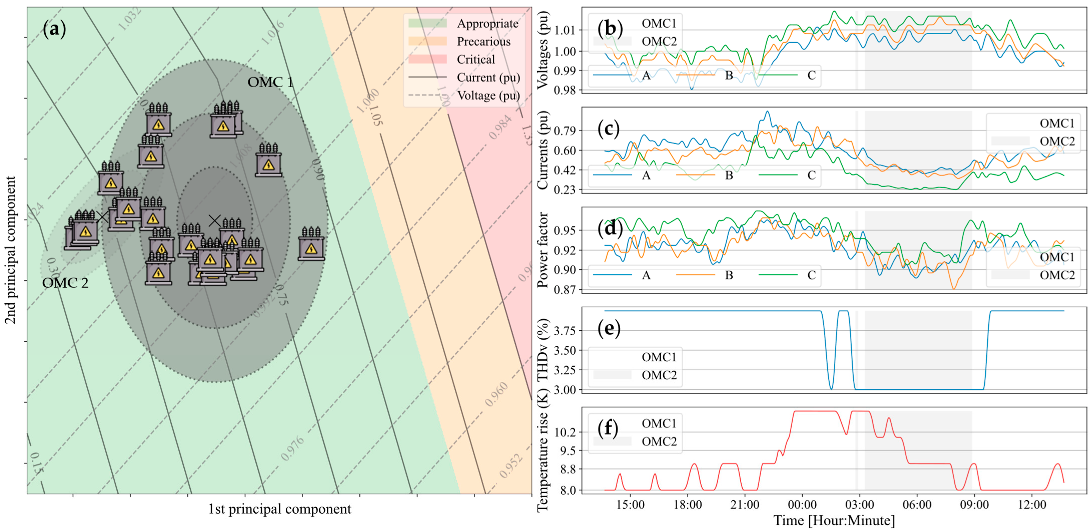
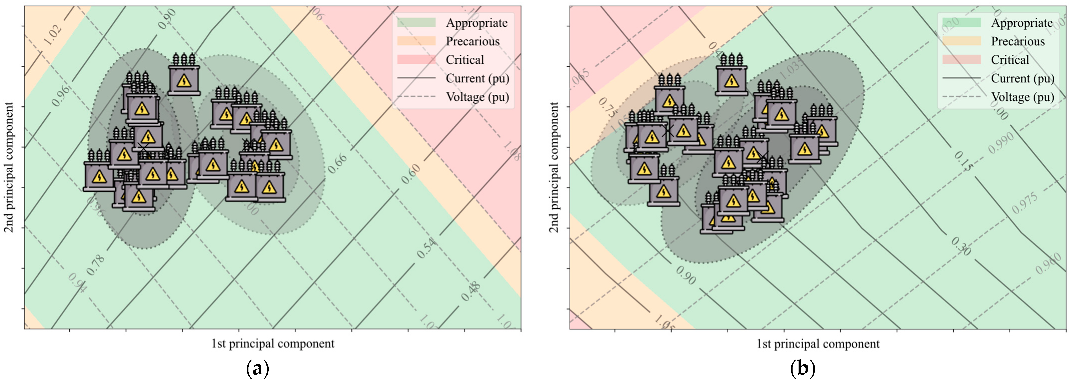
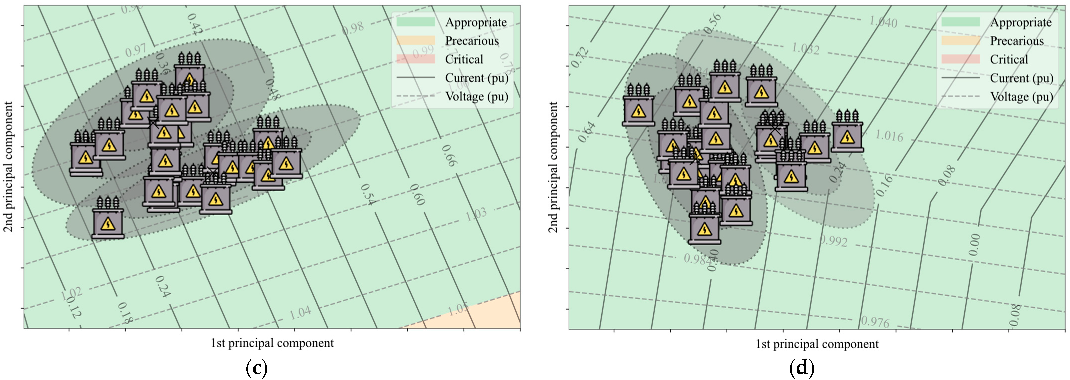
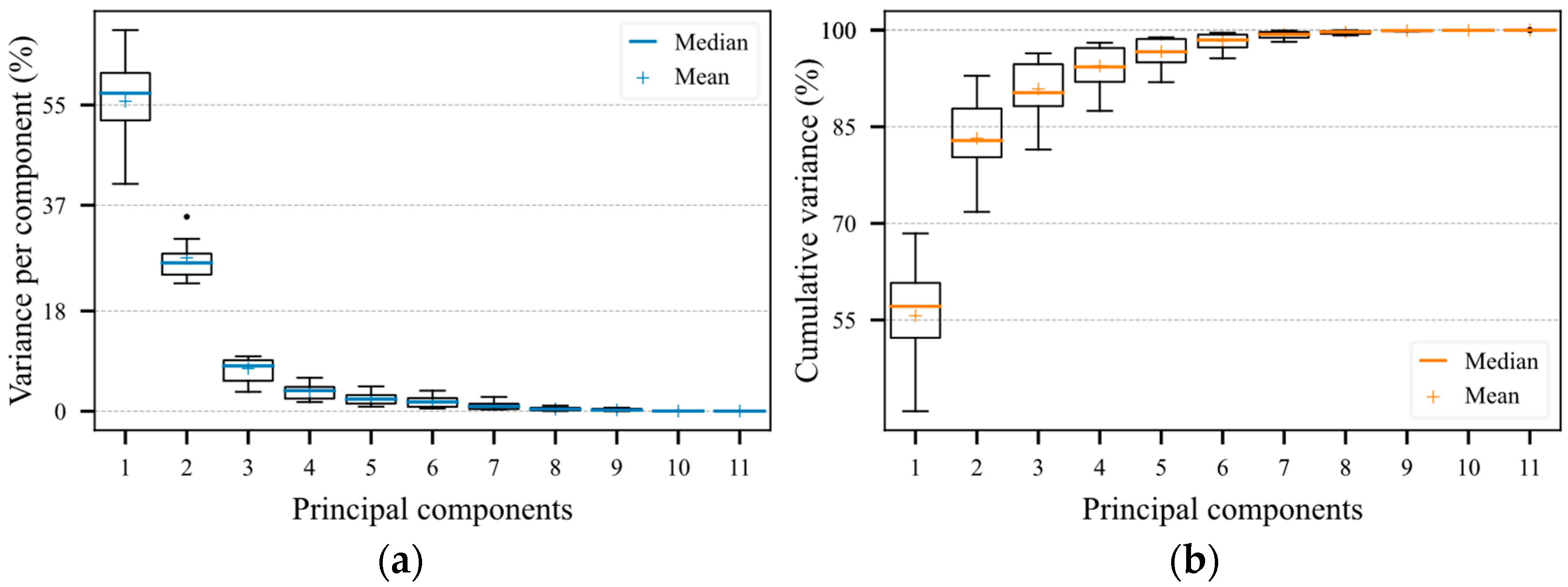


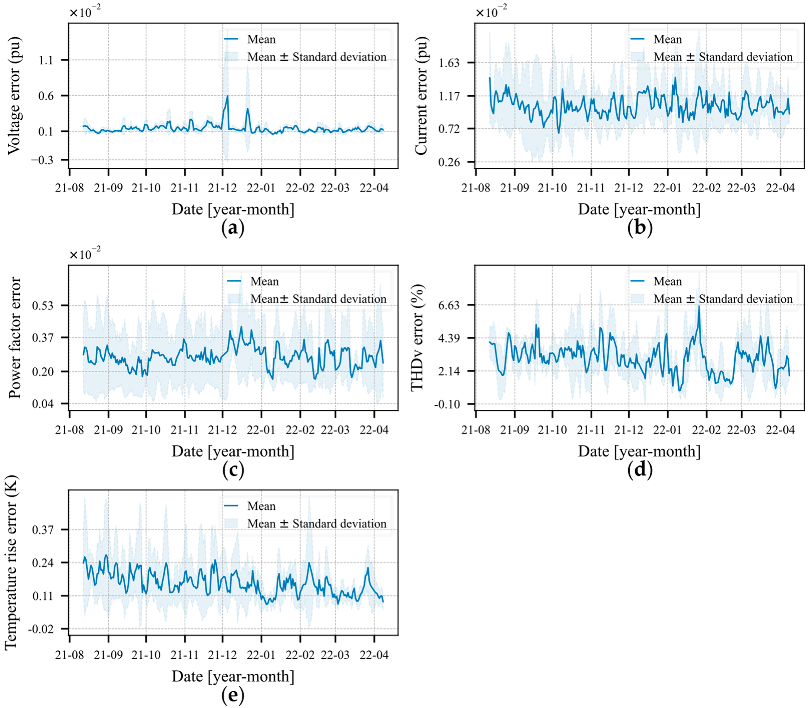

| Specifications | |
|---|---|
| AC Voltage measurement | 0 to 300 Vrms (precision ~0.05 Vrms) |
| AC Current measurement | 0 to 400 Arms (precision ~0.15 Arms) |
| Temperature measurement | 5 to 160 °C (precision ~0.4 °C) |
| Approximate dimensions (L × W × H) | 22 cm × 22 cm × 13 cm |
| Weight | ~2.7 kg |
| IP Rating | IP 66 |
| Enclosure Material | Aluminum, UV resistant paint |
| Communication | LoRaWAN Protocol Class A and Class C |
| Distribution Transformer | |||||
|---|---|---|---|---|---|
| 1 | 2 | 3 | 4 | 5 | |
| Power (kVA) | 112.5 | 150 | 150 | 225 | 150 |
| Rated HV voltage (kV) | 13.8 | 13.8 | 13.8 | 13.8 | 13.8 |
| Rated LV voltage (kV) | 0.38 | 0.38 | 0.38 | 0.38 | 0.38 |
| Cooling | ONAN 1 | ONAN | ONAN | ONAN | ONAN |
| No-load losses (kW) | 0.34 | 0.32 | 0.32 | 0.56 | 0.32 |
| Total losses (kW) | 1.71 | 1.55 | 1.55 | 2.94 | 1.55 |
| Start of operation | 04/09 2 | 02/08 | 10/13 | 12/16 | 02/08 |
| Start of monitoring | 08/21 | 08/21 | 09/21 | 09/21 | 09/21 |
| End of case study | 05/22 | 05/22 | 05/22 | 05/22 | 05/22 |
Publisher’s Note: MDPI stays neutral with regard to jurisdictional claims in published maps and institutional affiliations. |
© 2022 by the authors. Licensee MDPI, Basel, Switzerland. This article is an open access article distributed under the terms and conditions of the Creative Commons Attribution (CC BY) license (https://creativecommons.org/licenses/by/4.0/).
Share and Cite
Duarte, L.J.; Pinheiro, A.P.; Ferreira, D.O. A Real-Time Method to Estimate the Operational Condition of Distribution Transformers. Energies 2022, 15, 8716. https://doi.org/10.3390/en15228716
Duarte LJ, Pinheiro AP, Ferreira DO. A Real-Time Method to Estimate the Operational Condition of Distribution Transformers. Energies. 2022; 15(22):8716. https://doi.org/10.3390/en15228716
Chicago/Turabian StyleDuarte, Leandro José, Alan Petrônio Pinheiro, and Daniel Oliveira Ferreira. 2022. "A Real-Time Method to Estimate the Operational Condition of Distribution Transformers" Energies 15, no. 22: 8716. https://doi.org/10.3390/en15228716
APA StyleDuarte, L. J., Pinheiro, A. P., & Ferreira, D. O. (2022). A Real-Time Method to Estimate the Operational Condition of Distribution Transformers. Energies, 15(22), 8716. https://doi.org/10.3390/en15228716








